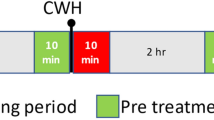Abstract
Alarm response triggered by physical stimuli is wide spread in termites but executed in several different behavioural patterns. The drywood and subterranean termite species tested in this study differed significantly by either head-drumming or jerking when stimulated by light, air-flow, or air borne sound stimuli. Nevertheless, differences may have a common evolutionary base. Repetitive stimuli of the same quality led to reduced responses over time, which was interpreted as habituation behaviour, a simple form of learning. Adaptation as alternative explanation was ruled out because when termites were subjected with a dis-habituation-stimulus followed by the original stimulus full response occurred again to this stimulus.







Similar content being viewed by others
References
Bremer S, Hertel H, Wachmann E (1993) Degeneration of the compound eye of the termite Neotermes jouteli (isoptera) in darkness during the phase of reproduction. Zoomorphology 113:205–210
Connétable S, Robert A, Bouffault F, Bordereau C (1998) Vibratory alarm signals in two sympatric higher termite species: Pseudacanthotermes spiniger and P. militaris (Termitidae, Macrotermitinae). J Insect Behav 12:329–342
Howse PE (1962) Oscillation movements in the termite Zootermopsis angusticollis Emerson. Symposia Genetica et biol it 9:256–268
Howse PE (1964) The significance of the sound produced by the termite Zootermopsis angusticollis (Hagen). Anim Behav 12:284–300
Kirchner WH (1997) Acoustical communication in social insects. In: Lehrer M (ed) Orientation and communication in arthropods. Birkhäuser, Basel, pp 273–300
Kirchner WH, Broecker I, Tautz J (1994) Vibration alarm communication in the damp-wood termite Zootermopsis nevadensis. Physiol Entomol 19:187–190
Maistrello L, Sbrenna G (1996) Frequency of some behavioural patterns in colonies of Kalotermes flavicollis (Isoptera: Kalotermitidae): the importance of social interactions and vibratory movements as mechanisms for social integration. Ethol Ecol Evol 8:365–375
Mankin RW, Osbrink WL, Oi FM, Anderson JB (2002) Acoustic detection of termite infestations in urban trees. J Econ Entomol 95(5):981–988
Reinhard J, Clément J-L (2002) Alarm reaction of European Reticulitermes termites to soldier head capsule volatiles (Isoptera, Rhinotermitidae). J Insect Behav 15:95–107
Röhrig A, Kirchner WH, Leuthold RH (1999) Vibrational alarm communication in the African fungus-growing termite genus Macrotermes (Isoptera, Termitidae). Insect Soc 46:71–77
Rosengaus RB, Jordan C, Lefebvre ML, Traniello JFA (1999) Pathogen alarm behavior in a termite: a new form of communication in social insects. Naturwissenschaften 86:544–548
Sbrenna G, Sbrenna Micciarelli A, Leis M, Pavan G (1992) Vibratory movements and sound production in Kalotermes flavicollis (Isoptera: Kalotermitidae). In: Billen J (ed) Biology and evolution of social insects. Leuven University Press, Leuven (Belgium), pp 233–238
Šobotník J, Hanus R, Roisin Y (2008) Agonistic behavior of the termite Prorhinotermes canalifrons (Isoptera: Rhinotermitidae). J Insect Behav 21:521–534
Stuart AM (1963) Studies in the communication of alarm in the termite Zootermopsis nevadensis (Hagen). Isoptera. Physiol Zool 36:69–84
Stuart AM (1988) Preliminary studies on the significance of headbanging movements in termites with special reference to Zootermoposis angusticollis (Hagen) (Isoptera: Hodotermitidae). Sociobiol 14:49–60
Thompson RF, Spencer WA (1966) A model phenomenon for the study of neuronal substrates of behaviour. Psychol Rev 73:16–43
Whitman JG, Forschler BT (2007) Observational notes on short-lived and infrequent behaviours displayed by Reticulitermes flavipes (Isoptera: Rhinotermitidae). Ann Entomol Soc Am 100:763–771
Author information
Authors and Affiliations
Corresponding author
Rights and permissions
About this article
Cite this article
Hertel, H., Hanspach, A. & Plarre, R. Differences in Alarm Responses in Drywood and Subterranean Termites (Isoptera: Kalotermitidae and Rhinotermitidae) to Physical Stimuli. J Insect Behav 24, 106–115 (2011). https://doi.org/10.1007/s10905-010-9240-x
Revised:
Accepted:
Published:
Issue Date:
DOI: https://doi.org/10.1007/s10905-010-9240-x




